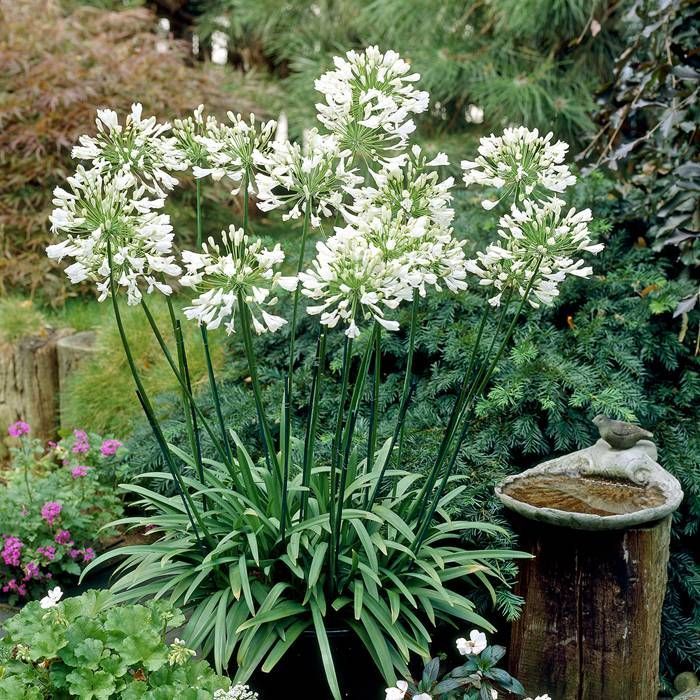Seasonal Agapanthus Care: Planning For Wintertime and Summer
Seasonal Agapanthus Care: Planning For Wintertime and Summer
Blog Article
Letting Loose the Secret to Successful Agapanthus Cultivation: Idea for a Flourishing Garden
In the realm of horticulture, cultivating agapanthus efficiently calls for a calculated technique that incorporates numerous aspects of plant care. By recognizing the subtleties of agapanthus cultivation, one can develop an environment where these plants prosper and bloom perfectly.
Planting Agapanthus: Ideal Practices
When planting Agapanthus, appropriate dirt preparation is crucial for ensuring effective growth and advancement of these beautiful flowers. Agapanthus, typically known as Lily of the Nile or African lily, prospers in well-draining soil with a somewhat acidic to neutral pH degree - Agapanthus. Before planting, it is crucial to change heavy clay dirts with natural issue such as garden compost or peat moss to enhance water drainage and give crucial nutrients for the plants
To grow Agapanthus, select a place that gets full sunshine to partial shade, as this will certainly promote healthy and balanced growth and bountiful blooming. Dig a hole twice the diameter of the plant's root ball and position the Agapanthus at the same depth it was previously growing. Delicately backfill the opening with soil, pushing down firmly to eliminate any kind of air pockets around the roots.
Water the newly planted Agapanthus thoroughly and remain to maintain the soil equally wet, particularly throughout the plant's energetic expanding season. Agapanthus. Using a balanced plant food once a month can even more support the plant's growth and blooming. By adhering to these ideal techniques for growing Agapanthus, you can develop a sensational screen of these fascinating blossoms in your yard
Suitable Dirt Conditions for Agapanthus
For ideal growth and blooming success of Agapanthus plants, ensuring the dirt conditions are perfect is crucial. Agapanthus prefers dirt that is abundant in nutrients, so incorporating a well balanced plant food throughout the growing season can advertise healthy growth and lively blossoms.

Watering and Fertilizing Tips
To make sure healthy and balanced growth and vibrant blooms, proper watering and fertilizing strategies are important for effective Agapanthus farming. Agapanthus plants benefit from routine watering, specifically during the growing period.
When it involves fertilizing Agapanthus, a well balanced plant food with equal parts nitrogen, phosphorus, and potassium can be applied in the spring to promote healthy development and blooming. Slow-release fertilizers are ideal for supplying nutrients gradually over an extensive period. Avoid over-fertilizing, as this can bring about extreme foliage development at the cost of flowers.
In addition, incorporating natural issue like garden compost into the dirt can boost nutrient levels and improve dirt structure, helping in the overall health of the Agapanthus plants. By adhering to these watering and feeding ideas, gardeners can ensure their Agapanthus plants thrive and create sensational display screens of flowers.
Pruning and Deadheading Techniques
Appropriate pruning and deadheading techniques play a crucial role in maintaining the health and aesthetic appeals of Agapanthus plants, matching the vital techniques of watering and feeding for successful farming. Pruning Agapanthus involves removing invested blossom heads, dead or yellowing leaves, and total shaping of the plant to advertise better development. Deadheading, the process of getting rid of faded blossoms, not just improves the plant's appearance however likewise encourages further flowering.
When deadheading Agapanthus, it is recommended to clip off the flower stem at the base utilizing sharp, tidy shears. This procedure reroutes the plant's energy from seed manufacturing back into origin and vegetation growth, advertising a much healthier and more robust plant. Regular deadheading can prolong the growing duration of Agapanthus and protect against self-seeding, which can cause overcrowding.
In regards to More about the author pruning, Agapanthus generally take advantage of a light trim after blooming to clean up the plant and motivate fresh growth. Cutting down the spent flower stems and removing any type of broken or dead vegetation assists keep the plant's vitality and overall appearance. Nevertheless, it is necessary to avoid reducing into the crown of the plant, as this can compromise its wellness.

Protecting Agapanthus From Pests and Diseases
Implementing reliable bug and condition monitoring strategies is critical to guarding the wellness and vigor of Agapanthus plants in growing. One usual pest that influences Agapanthus is the Agapanthus borer, a caterpillar that tunnels right into the plant, causing damage to the leaves and blossoms.
In enhancement to parasites, Agapanthus are susceptible to diseases such as origin rot and fungal fallen leave spots. By remaining alert and attending to parasite and condition problems without delay, gardeners can assist their Agapanthus grow and grow.

Conclusion
In verdict, effective growing of agapanthus needs appropriate planting strategies, excellent soil problems, adequate watering and fertilizing, routine trimming and deadheading, and security from parasites and conditions. By following these methods read this and suggestions, garden enthusiasts can ensure a flourishing yard loaded with beautiful agapanthus flowers. Agapanthus. Keep in mind to check out this site maintain consistent treatment and focus to information to advertise the health and longevity of these magnificent plants
When planting Agapanthus, appropriate dirt prep work is important for making sure effective growth and growth of these gorgeous flowers.Water the freshly grown Agapanthus extensively and continue to keep the dirt equally wet, especially during the plant's energetic expanding season.For ideal growth and flowering success of Agapanthus plants, making certain the dirt conditions are perfect is vital. When planting or hair transplanting Agapanthus, ensure the dirt is well-prepared to provide the needed structure for the plants to establish themselves effectively. One typical parasite that influences Agapanthus is the Agapanthus borer, a caterpillar that tunnels into the plant, causing damage to the blossoms and leaves.
Report this page